Welcome to our free classical music site

Do you write about classical music? Are you a blogger? Want to team up with Classical Connect? Send us a message, let's talk!

Do you write about classical music? Are you a blogger? Want to team up with Classical Connect? Send us a message, let's talk!
February 2, 2015. Mendelssohn and Palestrina. Felix Mendelssohn was born on February 3rd, 1809 in Hamburg into an eminent Jewish family. We had explored his family history and childhood years in our previous posts. Mendelssohn continues to be widely performed, especially his ever-popular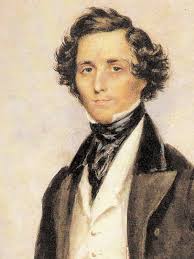 Violin concerto, the symphonies and the music for A Midsummer Night's Dream. His Songs Without Words for the piano also used to be performed often, but lately they pretty much disappeared from the concert repertoire. It’s a pity, as some of them are absolute gems. Mendelssohn wrote eight volumes (or books) of Songs, each consisting of just six songs. The first book was written in 1829-1830, and the first songs were written for the album of Felix’s beloved sister Fanny; the last one – in1842-1845, shortly before Mendelssohn’s premature death at the age of 38. Here are two Songs, both bearing subtitles (only few pieces have them): from Book 2, op. 30, no. 6, Allegretto tranquillo in F-sharp minor ("Venezianisches Gondellied" or Song of the Venetian gondolier), here, and the Spring song, from Book 5, Op. 62, also no. 6 (here). Both are performed by Daniel Barenboim; the recording was made in 1973.
Violin concerto, the symphonies and the music for A Midsummer Night's Dream. His Songs Without Words for the piano also used to be performed often, but lately they pretty much disappeared from the concert repertoire. It’s a pity, as some of them are absolute gems. Mendelssohn wrote eight volumes (or books) of Songs, each consisting of just six songs. The first book was written in 1829-1830, and the first songs were written for the album of Felix’s beloved sister Fanny; the last one – in1842-1845, shortly before Mendelssohn’s premature death at the age of 38. Here are two Songs, both bearing subtitles (only few pieces have them): from Book 2, op. 30, no. 6, Allegretto tranquillo in F-sharp minor ("Venezianisches Gondellied" or Song of the Venetian gondolier), here, and the Spring song, from Book 5, Op. 62, also no. 6 (here). Both are performed by Daniel Barenboim; the recording was made in 1973.
The music of Giovanni Pierluigi da Palestrina represents a pinnacle of the Renaissance. After about 150 years of development, starting with Guillaume Dufay, the music, the first truly “classical” one in our modern understanding, had reach unprecedented levels of individuality and sophistication. Palestrina, Orlando di Lasso, and their younger contemporaries Tomás Luis de Victoria and William Byrd – the Italian, the Fleming, the Spaniard and the English – perfected polyphony and thus influenced generations of composers, from Bach to composers of the 20th century. Palestrina, the oldest of the four, was born around this date in 1525 (as is so often the case with Renaissance composers, the real date is in dispute). He spent most of his life in Rome. The Pope Julius III recognized his talent and appointed Palestrina maestro di cappella of the Capella Giulia, the official choir of Saint Peter’s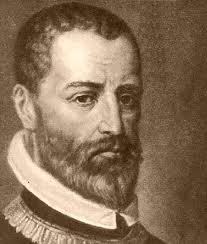 basilica. Later, Palestrina held similar positions in several other churches, including San Giovanni di Laterano, where Orlando served some years earlier, and Santa Maria Maggiore.
basilica. Later, Palestrina held similar positions in several other churches, including San Giovanni di Laterano, where Orlando served some years earlier, and Santa Maria Maggiore.
Palestrina, who composed most of his life, left a treasure trove of music: more than 100 masses, hundreds of madrigals and motets. He wrote Missa Brevis, a shorter mass, around 1570; at that time his was employed at the Santa Maria Maggiore, and his fame was spreading around Europe. By then he had received an offer from the Holy Roman Emperor Maximilan II (they ended up being unable to work out the terms) and was in an epistolary exchange with Guglielmo Gonzaga, the Duke of Mantua – they were discussing musical matters. Here’s the first part of the mass, Kyrie; it’s performed by The Tallis Scholars. Two years later he wrote a motet Tu Es Petrus. By then he had returned to the Saint Peter’s basilica and again was put in charge of the Capella Giulia. You can hear it in the performance by the choir of Westminster Abbey. Almost twenty years later, in 1591, Palestrina wrote several settings of Magnificat (the song of the Blessed Virgin Mary). Here’s one of them, Magnificat primi toni, performed by the English ensemble Voces8.
PermalinkJanuary 26, 2015. Mozart and Schubert. Two giants of classical music were born this week: Wolfgang Amadeus Mozart on January 27th of 1756 and Franz Schubert on January 31st of 1797. We’ve written about both of them numerous times, so to celebrate Mozart, we’ll just play his wonderful Linz symphony (no. 36). Vienna Philharmonic orchestra is conducted by Carlos Kleiber in a live 1988 performance.
Not only among Franz Schubert’s most beloved compositions, Die schöne Müllerin and Winterreise firmly established the song cycle as a genre rich in possibilities, and it would be taken up by some of the greatest song composers of the following century—Schumann, Brahms and Mahler. They were not the first of their kind, however. Beethoven’s An die ferne Geliebte predated the composition of both of Schubert’s cycle and laid the groundwork for the importance of musical continuity across the individual songs of the cycle. Yet, it was Schubert’s cycles that were the first to be widely performed and successful.
The earlier of the two cycles, Die schöne Müllerin was largely composed between May and September 1823, while Schubert was also at work on his opera Fierrabras, and was published the following year. Schubert selected twenty poems from Wilhelm Müller’s collection, excluding among others a prologue and epilogue, to use for his cycle, yet the narrative of the cycle is unharmed. The story follows the plight of a young miller that falls hopelessly in love with a miller maid. Blissful and full of life, he takes great joy in his wanderings. His companion in his journeys is a brook, that, whether for good or evil is yet not known, leads him to a mill. While working at the mill, he becomes infatuated with the master’s daughter, and attempts to win her heart. Though he believes he has gained her affections, his hopes of happiness are ruined by the arrival of a hunter, dressed in green. Jealously rises in the young miller and he develops a fatal obsession with the color green. Finally, he loses all hope and finds only rest in the cold embrace of his faithful companion, the brook.
The narrative of Die schöne Müllerin begins with the young man’s blissful wanderings in Das Wandern ("Wanderings," play). As he walks alongside the brook, watching its continuous journey and the ceaseless turning of the wheels of the mill, he muses that all things must move—must wander. Schubert sets Müller’s five-stanza poem in a simple strophic setting in B-flat major. The young man’s blithe approach to life is expressed in the almost folk-like characteristics of the song: a simple, unadorned melody and harmonies that hardly depart from the tonic and dominant of the key. Important, however, is the rippling accompaniment of sixteenth notes that depicts the scenic brook, one of the cycle’s three main characters. Continue
PermalinkJanuary 21, 2015. Lutoslawski and Dutilleux. Two wonderful composers, both born in the 1910s, have their birthdays this week. The Polish Witold Lutoslawski was born on January 25th of 1913. As we wrote two years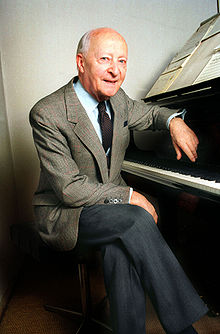 ago, Lutoslawksi’s life was exceptionally difficult, even by tough east-European standards of the 20th century. An aspiring composer in the pre-War years, a student of Nadia Boulanger in Paris, he returned to Poland on the eve of WWII. As the Germans invaded the country, he was conscripted and shortly after captured by the Germans. He escaped eight days later and made it to Warsaw (his younger brother was captured by the Red Army and died in the Gulag a year later). During the occupation, he earned his living by playing piano in bars together with his best friend, Andrzej Panufnik. Just before the heroic and ill fated Warsaw Uprising was to begin, his mother took him to a small town of Komorów, just outside of the city. Things didn’t get much better after the Soviet Union installed a communist regime in Poland. After several relatively liberal years, in 1949 Lutoslawki became the first composer to be officially banned by the Composer’s Union. The ban lasted for almost 10 years, even after Stalin’s death. During those difficult years Lutoslawki survived by writing children songs, and music for theater and radio plays. As he couldn’t use his own name, he wrote under the pseudonym of "Derwid." It’s worth noting that he didn’t write a single piece in the Socialist Realism style, as was expected from him and as so many of his contemporaries in Easter Europe were forced to do (or chose to). Another difficult period came in the 1980s: Lutoslawki actively supported the Solidarity movement, and suffered when its leadership was suppressed by the Communist regime. In defiance, Lutoslawki started what he termed “the boycott of the State,” refusing to conduct, to meet with officials and rebuffing all entreaties from the State.
ago, Lutoslawksi’s life was exceptionally difficult, even by tough east-European standards of the 20th century. An aspiring composer in the pre-War years, a student of Nadia Boulanger in Paris, he returned to Poland on the eve of WWII. As the Germans invaded the country, he was conscripted and shortly after captured by the Germans. He escaped eight days later and made it to Warsaw (his younger brother was captured by the Red Army and died in the Gulag a year later). During the occupation, he earned his living by playing piano in bars together with his best friend, Andrzej Panufnik. Just before the heroic and ill fated Warsaw Uprising was to begin, his mother took him to a small town of Komorów, just outside of the city. Things didn’t get much better after the Soviet Union installed a communist regime in Poland. After several relatively liberal years, in 1949 Lutoslawki became the first composer to be officially banned by the Composer’s Union. The ban lasted for almost 10 years, even after Stalin’s death. During those difficult years Lutoslawki survived by writing children songs, and music for theater and radio plays. As he couldn’t use his own name, he wrote under the pseudonym of "Derwid." It’s worth noting that he didn’t write a single piece in the Socialist Realism style, as was expected from him and as so many of his contemporaries in Easter Europe were forced to do (or chose to). Another difficult period came in the 1980s: Lutoslawki actively supported the Solidarity movement, and suffered when its leadership was suppressed by the Communist regime. In defiance, Lutoslawki started what he termed “the boycott of the State,” refusing to conduct, to meet with officials and rebuffing all entreaties from the State.
As most composers, Lutoslawki went through many creative stages. His composing style was changing and evolving his whole life. During some periods it was more modernistic, atonal and even aleatoric, with chance playing a role in note selection, in others? – more tonality-based, almost romantic. Here, from his twelve-tone period, is String Quartet, written in 1954, it’s performed by the New Budapest Quartet. A much "warmer" but still atonal is Lutoslawski’ orchestral piece called Mi-Parti from 1976. It was recorded the same year by the Polish National Radio Symphony Orchestra with the composer conducting. You can listen to it here.
Lutoslawski died in Warsaw on February 9th of 1994. Henri Dutilleux, three year younger than Lutoslawski (he was born on January 22nd of 1916), had a longer life: he died in 2013 at the ripe age of 97. And even though he, like Lutoslawski, lived through the war (and also earned money playing piano in his respective occupied capital), overall his career was a happier one. Throughout his life his achievements were acknowledged by his peers and his country, from the Grand Prix du Rome which he won in 1938 to the highest honor a Frenchmen can receive – the Grand Cross of the Legion of Honor, which he received in 2004. He received commissions from many orchestras and musicians, and taught in several important conservatories. Dutilleux’s place in French music is quite unique: on the one hand, he was influenced, even if indirectly, by Debussy and Ravel, and also by Stravinsky and Bartok; on the other, he never belonged to any musical school, even frowned at them and maintained independence all his life. You can hear some of these influences – the beauty of the orchestral writing combined with a contemporary, almost jazzy edge – in the orchestral piece called Metaboles, as a simple musical structure moves though the different sections of the orchestra, gaining complexity in the process. Metaboles was commissioned in 1965 by George Szell for the Cleveland Orchestra; here it’s performed by the Boston Symphony under the direction of Alan Gilbert.
PermalinkJanuary 12, 2015. Morton Feldman. Last week, as we celebrated Alexander Scriabin’s anniversary, we had to pass over several birthdays, like Nikolai Medtner’s and Francis Poulenc’s. This week is not as rich: many names but few first-rate talents. Ermanno Wolf-Ferrari, born on January 12th of 1876 was considered the best composer of comic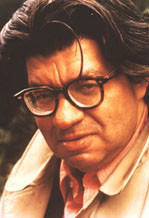 operas of his time; now he’s practically forgotten. Another Italian, Niccolò Piccinni (born on January 16th of 1728), was also a very popular opera composer: he wrote for the Paris Opera and was considered Gluck’s equal. The only problem is that none of his works are staged these days; they’re just not very good. A Russian composer with a very French name, Cesar Cui, was also born this week, on January 18th of 1835. He’s the least interesting of the Mighty Five. Some of his songs are very nice but not much more is performed outside of Russia. The most significant composer of those born this week is the American Morton Feldman. The problem with him is different: in his mature years he wrote enormously long and sometimes difficult compositions and for that reason they are rarely performed.
operas of his time; now he’s practically forgotten. Another Italian, Niccolò Piccinni (born on January 16th of 1728), was also a very popular opera composer: he wrote for the Paris Opera and was considered Gluck’s equal. The only problem is that none of his works are staged these days; they’re just not very good. A Russian composer with a very French name, Cesar Cui, was also born this week, on January 18th of 1835. He’s the least interesting of the Mighty Five. Some of his songs are very nice but not much more is performed outside of Russia. The most significant composer of those born this week is the American Morton Feldman. The problem with him is different: in his mature years he wrote enormously long and sometimes difficult compositions and for that reason they are rarely performed.
Feldman was born on January 12th of 1926 in New York into a family of Russian-Jewish immigrants. As a child he studies piano and then composition; both of his teachers were followers of the New Viennese school of Schoenberg and Webern. When he was 24 Feldman met John Cage and they became fast friends; Feldman even moved into the same building where Cage lived. By then Cage, 14 years older than Feldman, was already well known in the avant-garde circles of New York. Cage introduced Feldman to a number of musicians and painters, such as Cage’s teacher the composer Henry Cowell, Virgil Thompson, George Antheil and Robert Rauschenberg. The 1950s were the golden age of Abstract Expressionism and Feldman became highly influenced by the art of Jackson Pollock, Mark Rothko and, especially, Philip Guston, who was then going through his abstract phase. Years later, in 1984, Feldman would write a four hour-long piece in memory of their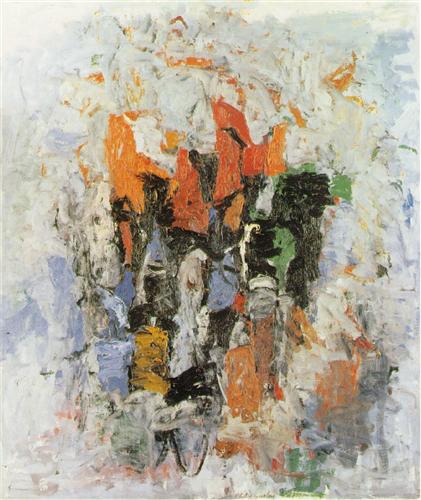 friendship. Called For Philip Guston it’s scored for flute, percussion and piano. The painting “Clock,” on the right, was made by Guston around 1956-57. Of course there’s no clock in sight.
friendship. Called For Philip Guston it’s scored for flute, percussion and piano. The painting “Clock,” on the right, was made by Guston around 1956-57. Of course there’s no clock in sight.
Feldman created a unique graphic system of music notation, within which many things were undetermined and left for performers to interpret. Sometimes it was the pitch, at other times the duration. Somehow, when you listen to his music, the results are always pure Feldman: sparse, whispering, exquisite, atonal but often lyrical, with a tremendous weight given to every sound (or silence), and often insanely long. In 1971 he wrote a piece called Rothko Chapel in memory of his friend Mark Rothko, who committed suicide a year earlier. The chapel, located in Houston, contains 14 large paintings by Rothko. You can listen to Feldman’s tribute to his friend here, it’s performed by members of the Seattle Modern Orchestra. The melody for the viola at the end of the piece was written by Feldman when he was 15. Rothko Chapel is a relatively short piece, it runs for about 24 minutes. Palais de Mari for the piano, written in 1986, was Feldman’s last piano work: he died of cancer on September 3rd, 1987. It’s performed here by Aki Takahashi, a Japanese pianist who premiered several of Feldman’s works. In her interpretation Palais de Mari runs for about 29 minutes.
Permalink
January 5, 2015. Scriabin. Alexander Scriabin was born in Moscow on January 6th of 1872. In 1872 Russia was still using the Julian calendar, and January 6th for those living according to the Gregorian calendar was Christmas Day, December 25th.. Scriabin’s father belonged to a minor Moscow nobility and later in his life would become a prominent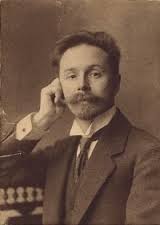 Russian diplomat, his mother was a concert pianist. She died of consumption when Alexander was one year old; she was only 23. Anton Rubinstein, who was for a while his mother’s teacher, took interest in Alexander. By the age of five Scriabin was already playing piano; from an early age he showed interest in composing. He took private lessons with Taneyev and other prominent musicians and later entered the Moscow Conservatory, studying piano with the famous Vasily Safonov, graduating with a gold medal (Sergei Rachmaninov graduated from the Conservatory the same year, also with a gold medal, but of an even higher rank). In 1898 Scriabin was invited to his alma mater as a professor of composition but quit soon after because teaching interfered with his own work. Around this time he became well known as a composer. Scriabin’s early compositions, mostly for the piano, are very pleasant but quite derivative, written in imitation of Chopin’s sonorities: listen, for example, to his Etude in c-sharp minor, op. 2, no. 1 in the performance by Daniil Trifonov (herer). In 1903 Scriabin and his wife Vera, the mother of their four children, left Russia for Switzerland. By then Scriabin was already involved with the 20-year old Tatiana Schloezer. Shortly after the Scriabins legally separated, Schloezer joined Scriabin as his second, common-law wife (they had three more children together; one of them, Julian, who drowned at the age of 11, was a composer who wrote several preludes in the late style of his father). Schloezer, despite her age, was a strong-willed woman who worshiped Scriabin. Some of Scriabin’s friends accepted Schloezer, some refused to do so (Safonov, a former teacher and good friend, stopped talking to Scriabin). The Swiss period marked a significant development in Scriabin’s music. It became highly individual, idiosyncratic. The Fourth and the Fifth Piano sonata and the famous Poem of Ecstasy, which he started in 1905, are great examples of his art of the period (here’s Sonata no. 4 in the F-sharp Major, op. 30, performed by Vassily Primakov). In 1907 Scriabin moved to Paris where for a brief period he got involved with the famous impresario Sergei Diaghilev, and then to Brussels. Short on money (his major Russian patrons cut their funding), he made a trip to New York. Unfortunately, it wasn’t successful. In 1910 Scriabin returned to Russia and stayed there for the few remaining years of his life.
Russian diplomat, his mother was a concert pianist. She died of consumption when Alexander was one year old; she was only 23. Anton Rubinstein, who was for a while his mother’s teacher, took interest in Alexander. By the age of five Scriabin was already playing piano; from an early age he showed interest in composing. He took private lessons with Taneyev and other prominent musicians and later entered the Moscow Conservatory, studying piano with the famous Vasily Safonov, graduating with a gold medal (Sergei Rachmaninov graduated from the Conservatory the same year, also with a gold medal, but of an even higher rank). In 1898 Scriabin was invited to his alma mater as a professor of composition but quit soon after because teaching interfered with his own work. Around this time he became well known as a composer. Scriabin’s early compositions, mostly for the piano, are very pleasant but quite derivative, written in imitation of Chopin’s sonorities: listen, for example, to his Etude in c-sharp minor, op. 2, no. 1 in the performance by Daniil Trifonov (herer). In 1903 Scriabin and his wife Vera, the mother of their four children, left Russia for Switzerland. By then Scriabin was already involved with the 20-year old Tatiana Schloezer. Shortly after the Scriabins legally separated, Schloezer joined Scriabin as his second, common-law wife (they had three more children together; one of them, Julian, who drowned at the age of 11, was a composer who wrote several preludes in the late style of his father). Schloezer, despite her age, was a strong-willed woman who worshiped Scriabin. Some of Scriabin’s friends accepted Schloezer, some refused to do so (Safonov, a former teacher and good friend, stopped talking to Scriabin). The Swiss period marked a significant development in Scriabin’s music. It became highly individual, idiosyncratic. The Fourth and the Fifth Piano sonata and the famous Poem of Ecstasy, which he started in 1905, are great examples of his art of the period (here’s Sonata no. 4 in the F-sharp Major, op. 30, performed by Vassily Primakov). In 1907 Scriabin moved to Paris where for a brief period he got involved with the famous impresario Sergei Diaghilev, and then to Brussels. Short on money (his major Russian patrons cut their funding), he made a trip to New York. Unfortunately, it wasn’t successful. In 1910 Scriabin returned to Russia and stayed there for the few remaining years of his life.
During this time his music evolved even further. Its harmonies grew so complex that the basic tonality became practically irrelevant. Scriabin started talking about his music more in painter’s terms, putting emphasis on such qualities as radiance, sharpness, or brilliancy. Around the same time Scriabin became obsessed with the relationship between color and musical tone. In 1910 he wrote a symphonic poem Prometheus and added a special line to score for the color accompaniment using a special machine called clavier à lumières. He specified that C should be projected in red color, D – yellow, and so on, for all 12 notes of the octave. Only one version of this instrument was ever used, in the performance of Prometheus in New York in 1915.
Scriabin died on April 27th of 1914 of septic shock after a boil on his upper lip got infected as he tried to get rid of it. He was 43. One of the greatest interpreters of his music was the Russian pianist Vladimir Sofronitsky (1901-1961), who married Scriabin’s eldest daughter, Elena. Sofronitsky is not very well known in the West, which is quite unfortunate: some of his recordings were at the highest possible level. Here is the recording made by Sofronitsky of Scriabin’s late Sonata no. 9, op. 68, subtitled “Black Mass.” The recording was made in 1960. We’ll dedicate an entry to the art of Sofronitsky at a later date.
PermalinkDecember 29, 2014. Happy New Year! 2015 is fast approaching, and following yet another serendipitous tradition that was established at Classical Connect over the last several years, we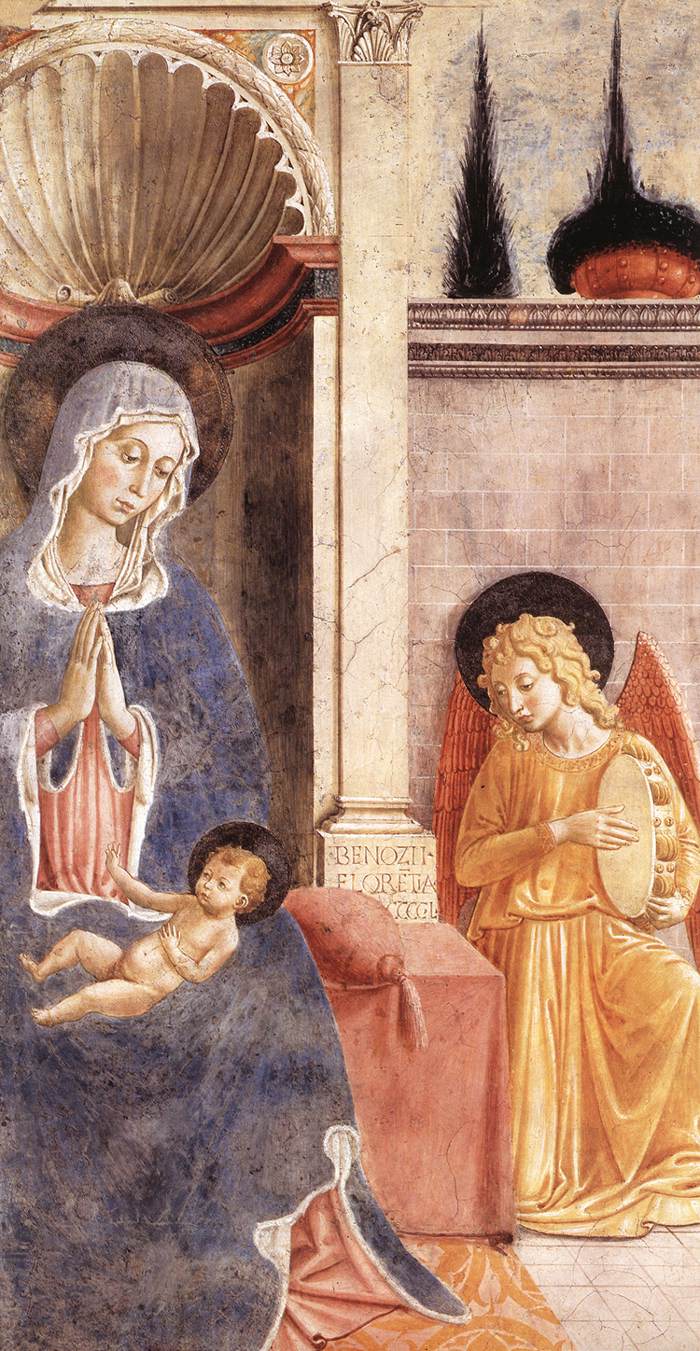 dedicate the last annual entry to a composer with an unknown birthdate. For obvious reason, these composers usually come from the age when record-keeping was not very accurate. During Medieval times not only the birthdate, but often the name and the music itself were usually lost, so our composers come from the period that followed, the Renaissance. Orlando di Lasso (or Orlande de Lassus, as his name is sometimes written) was one such composer. He was born either in 1530 or 1532 in the town of Mons, in the County of Hinaut in what is now Belgium (Gilles Binchois, another famous composer of the Renaissance, was born in Mons 130 years earlier). It is said that as a boy, Orlando had a very beautiful voice – according to a legend he was even kidnapped for it, not once, but three times. When Orlando was 12, Ferrante Gonzaga, of the Mantuan Gozagas, a condottiero close to the Emperor Charles V, heard him sing and made Orlando part of his entourage. Gonzaga’s travels brought Orlando to Italy, Mantua first, then Sicily and Milan. He then moved to Rome, to the household of Cosimo I de’ Medici, the grand duke of Tuscany (despite the title, Cosimo was from a minor branch of the great family that ruled over Florence in the 15th century). He then received a very prestigious position as the maestro di capella at the basilica of Saint John Lateran, the second most important church in Rome (Palestrina would succeed him several years later). He started publishing his music around that time, and in several years became famous not just in Italy, but in all of civilized Europe.
dedicate the last annual entry to a composer with an unknown birthdate. For obvious reason, these composers usually come from the age when record-keeping was not very accurate. During Medieval times not only the birthdate, but often the name and the music itself were usually lost, so our composers come from the period that followed, the Renaissance. Orlando di Lasso (or Orlande de Lassus, as his name is sometimes written) was one such composer. He was born either in 1530 or 1532 in the town of Mons, in the County of Hinaut in what is now Belgium (Gilles Binchois, another famous composer of the Renaissance, was born in Mons 130 years earlier). It is said that as a boy, Orlando had a very beautiful voice – according to a legend he was even kidnapped for it, not once, but three times. When Orlando was 12, Ferrante Gonzaga, of the Mantuan Gozagas, a condottiero close to the Emperor Charles V, heard him sing and made Orlando part of his entourage. Gonzaga’s travels brought Orlando to Italy, Mantua first, then Sicily and Milan. He then moved to Rome, to the household of Cosimo I de’ Medici, the grand duke of Tuscany (despite the title, Cosimo was from a minor branch of the great family that ruled over Florence in the 15th century). He then received a very prestigious position as the maestro di capella at the basilica of Saint John Lateran, the second most important church in Rome (Palestrina would succeed him several years later). He started publishing his music around that time, and in several years became famous not just in Italy, but in all of civilized Europe.
In 1556 Orlando was hired by the court of the Duke of Bavaria. He moved to Munich and remained there for the rest of his life. His fame continued to grow; composers would visit him in Munich, the Pope knighted him, he was invited to many courts. Only Palestrina could compete with Orlando in popularity. He made several visits to Italy, but despite all offers always returned to Bavaria. In his last years his health declined; he died on June 14th of 1594 and was buried in Munich.
Orlando was immensely prolific. Apparently he wrote over 2000 pieces of music, sacred (masses and motets), as well as secular (madrigals and chansons). The cycle of motets called Cantiones sacrae sex vocum (Sacred songs for six voices) was published the year of his death, in 1594. Here are three of these songs: Ad Dominum cum tribularer, Beatus homo, and Cantabant canticum Moysi. They are performed by Collegium Vocale Gent under direction of Philippe Herreweghe. The Madonna and Child (above) are by the Florentine painter Benozzo Gozzoli. It was completed in 1450.Permalink